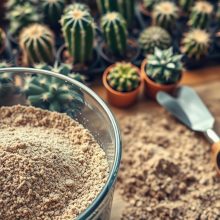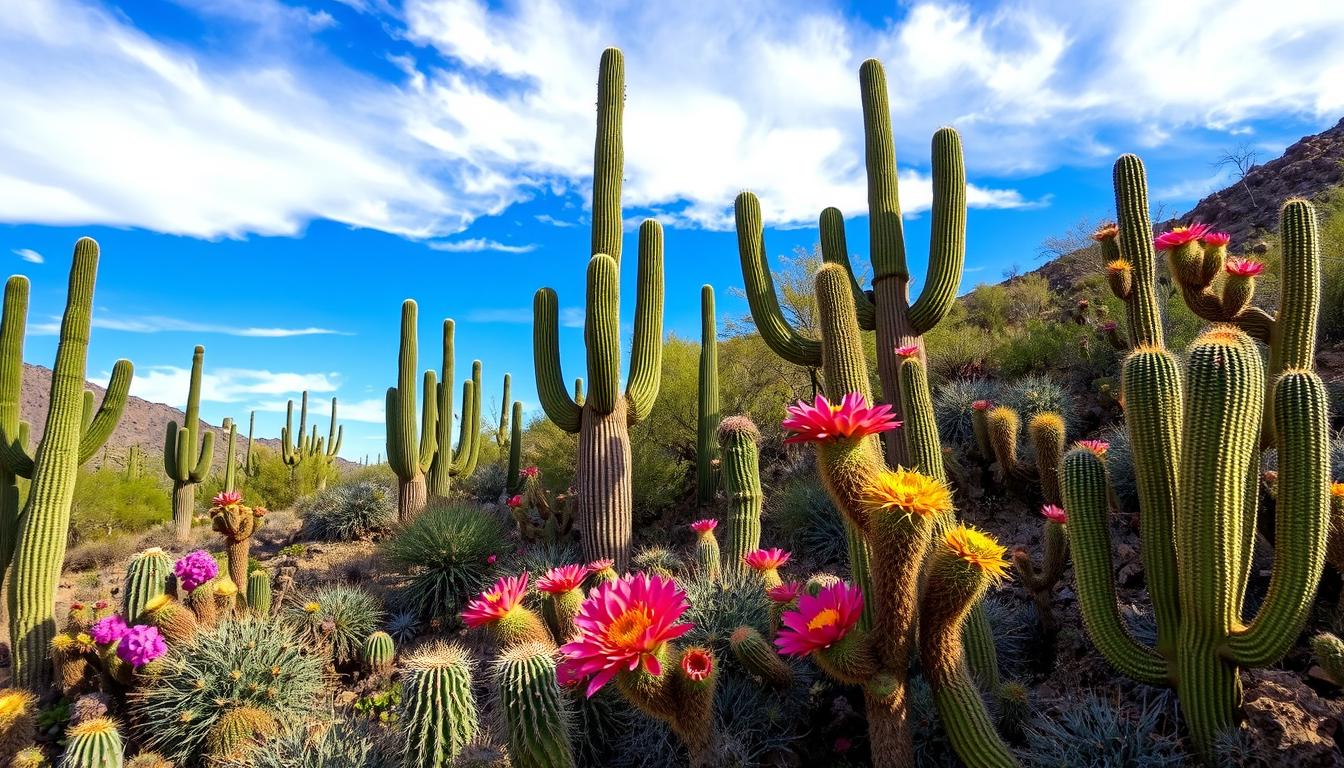How to Water Cactus: A Complete Guide for Success
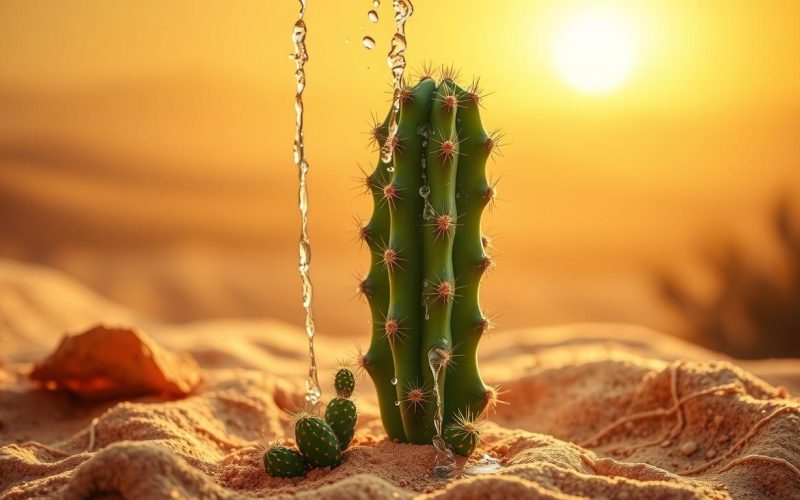
Cacti have fascinated many with their unique shapes and survival skills. Knowing how to care for them and water them right is key. Many think these plants need little care, but they actually need careful watering.
This guide will show you how to water cacti, helping both new and seasoned plant lovers. We’ll dive into the world of desert plant care, sharing tips for keeping these plants healthy through smart watering.
Cacti are more than just plants; they’re living examples of desert survival. Learning what they need in terms of water can change how you care for them. This ensures they do well in different places.
Key Takeaways
- Understand unique water requirements of different cactus species
- Learn precise watering techniques for optimal plant health
- Recognize signs of under and overwatering
- Develop a strategic approach to cactus hydration
- Master environmental factors affecting cactus water needs
Understanding Cactus Watering Needs
Cacti are amazing desert plants with special water storage. They are different from other houseplants. These plants have learned to live in harsh places with little water.
Importance of Proper Watering
Watering cacti right is more than just adding water. They store water in their stems and roots. This lets them go without water for a long time.
This special way of storing water means too much water is bad. It’s better to water them less than too much.
- Water storage prevents rapid dehydration
- Thick stems act as water reservoirs
- Minimal water requirements compared to other plants
Common Misconceptions
Many people think cacti don’t need water. But, they actually need careful watering to stay healthy. They can live with less water, but they still need some during their growing seasons.
Factors Influencing Watering Frequency
- Species-specific water requirements
- Pot size and drainage capabilities
- Environmental temperature and humidity
- Seasonal growth patterns
Knowing these factors helps make a good plan for caring for cacti. It keeps them healthy and stops water problems.
Types of Cacti and Their Watering Requirements
Cacti come in many varieties, each needing different care. Knowing what each cactus needs helps them grow well and stay healthy.
Cacti are mainly divided into desert and forest types. These groups affect how much water they need and how they should be cared for.
Saguaro Cactus
The Saguaro cactus is a desert cactus from the Sonoran Desert. It needs very little water because it’s used to dry places. To care for a Saguaro, you should:
- Water it rarely when it’s growing
- Let the soil dry out completely before watering again
- Give it less water in the winter
Barrel Cactus
The Barrel cactus also lives in the desert and needs similar care to the Saguaro. To care for a Barrel cactus, you should:
- Water it only when the soil is dry
- Use soil that drains well
- Keep it away from too much moisture
Christmas Cactus
The Christmas cactus comes from tropical forests, not deserts. It needs more water than desert cacti. To care for a Christmas cactus, you should:
- Water it regularly when the soil feels dry
- Keep the air around it more humid
- Water it more often when it’s growing
Understanding these differences helps you give the right care to your cactus. This way, your cactus can grow strong and live a long life.
Ideal Environment for Cactus Growth
To grow cacti well, you need to know their special needs. These plants are great at surviving in dry places. They grow best in certain conditions that help them thrive naturally.
Temperature and Humidity Considerations
Cacti come from very dry places and like certain temperatures. They do best in daytime temperatures between 70-100°F. At night, they can handle cooler temperatures.
They also need very low humidity. This is because they live in very dry areas.
- Ideal daytime temperature: 70-100°F
- Preferred humidity levels: Low (20-30%)
- Nighttime temperature tolerance: 50-60°F
Light Requirements
Light is very important for cacti. Most need bright, direct sunlight for 4-6 hours a day. But, different cacti need different amounts of light.
- Bright direct sunlight: 4-6 hours daily
- Protect from intense midday heat
- Rotate plants for even light exposure
Soil Types for Cacti
Good drainage is key for cacti. They need a special soil mix that lets water drain fast. This mix should be like their desert home.
- Use sandy, gravelly soil mixes
- Ensure excellent drainage
- Avoid heavy, moisture-retaining soils
Signs Your Cactus Needs Water
Knowing how to water your cactus is key to keeping it healthy. Cacti are tough, but they still show when they need water. Spotting these signs helps you care for your cactus right and avoid harm.
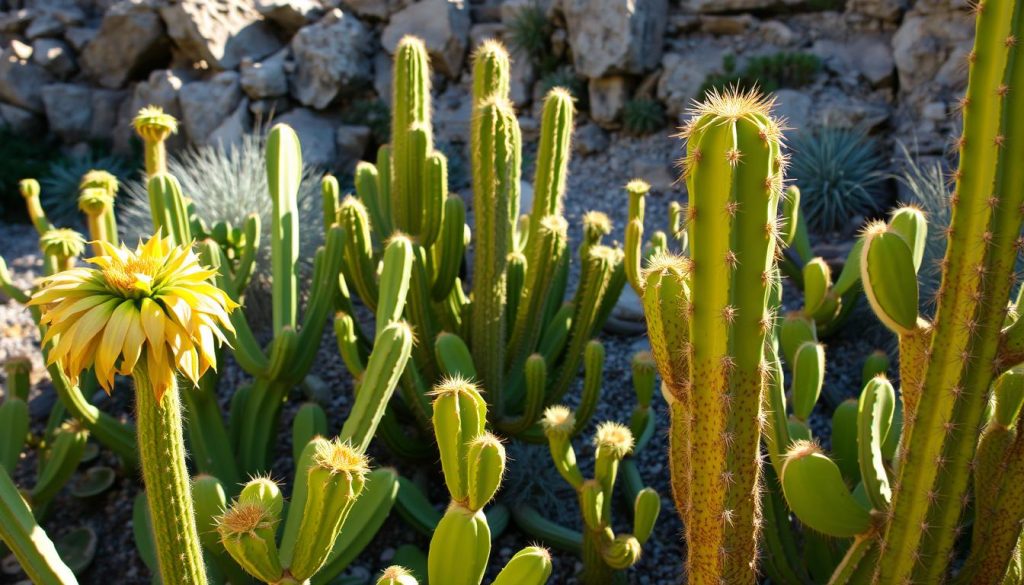
Visual Indicators of Water Stress
Spotting when your cactus needs water takes some eye work. Look out for these signs that mean it’s time to water:
- Slight wrinkling or shriveling of the skin
- Reduced plumpness in the plant’s body
- Dull or faded color appearance
- Soft or mushy texture in specific areas
Soil Moisture Testing Techniques
Checking soil moisture is more than just looking. Try these methods:
- Use a wooden dowel or skewer to check soil dryness
- Insert your finger about 1-2 inches into the soil
- Utilize a digital moisture meter for precise readings
Seasonal Watering Considerations
Watering needs change with the seasons. In spring and summer, cacti need more water. But in winter, they drink much less. Adjust your watering based on the season and your cactus’s growth.
Watering Techniques for Cacti
Learning how to water your cactus is key to keeping it healthy. Low-water gardening needs a careful touch when it comes to watering. Each cactus type has its own watering needs, so picking the right method is important for growth.
Watering right is more than just adding water. It’s about using the right strategies to avoid harming the roots and keep the plant healthy. Choosing the right technique can make a big difference in your cactus’s health.
Deep Watering Method
The deep watering method means soaking the soil well and making sure it drains completely. Here’s how to do it:
- Use a pot with drainage holes
- Water slowly around the base
- Keep watering until water comes out of the holes
- Let the soil dry out completely before watering again
Drip Irrigation Strategy
Drip irrigation gives your succulents a steady, controlled amount of water. It helps save water and lowers the chance of overwatering in dry environments.
- Put a drip system near the cactus roots
- Set a timer for deep, infrequent waterings
- Adjust as the seasons change
Watering from Below
Bottom watering lets roots soak up water naturally. Place the cactus pot in a shallow dish of water. This way, the plant drinks from the bottom, avoiding damage to its surface and reducing rot risks.
How Often to Water Your Cactus
Cactus care needs a careful approach to watering. This changes with the seasons and how the plant grows. Knowing your cactus’s water needs is key to its health.
- Seasonal growth patterns
- Indoor versus outdoor environment
- Specific cactus species
- Local climate conditions
Seasonal Watering Guidelines
In the growing seasons (spring and summer), cacti need more water. You should water them every 7-10 days. But in winter, they need much less, about once every 4-6 weeks.
Indoor vs. Outdoor Cactus Watering
Indoor cacti and outdoor ones have different needs. Indoor plants need less water because of the stable environment. Outdoor plants, exposed to sun and weather, need more water.
- Indoor cacti: Water every 2-3 weeks
- Outdoor cacti: Water every 7-10 days during growing season
- Winter watering: Reduce frequency by 50-75%
Good cactus care means watching and adjusting. Always check the soil before watering. Change your schedule as needed for your plant and environment.
Risks of Overwatering Cacti
Watering cacti right is key. Too much water can harm your desert plant badly. Knowing the dangers helps keep your cactus safe from water harm.
Cacti live well in dry places, storing water in their thick parts. Too much water makes them weak to serious problems.
Root Rot Symptoms
Spotting early signs of too much water is important. Look out for these signs:
- Soft, mushy base of the plant
- Discoloration near the soil line
- Browning or blackening of plant tissue
- Unusual smell of decay
Long-Term Effects on Growth
Too much water hurts cacti a lot. It damages their roots, stops them from getting nutrients, and can kill them.
Prevention Strategies
Here are ways to keep your cactus safe:
- Use well-draining soil mixtures
- Select pots with drainage holes
- Water only when top soil is completely dry
- Adjust watering frequency based on seasonal changes
Keeping your cactus safe from water damage needs careful watching and knowing its needs. By spotting risks and using smart watering, your desert plant can do well.
Best Practices for Cactus Watering
Learning how to water cactus is key to keeping your plant healthy. It’s not just about pouring water on it. The right way can make your cactus grow well and avoid harm.
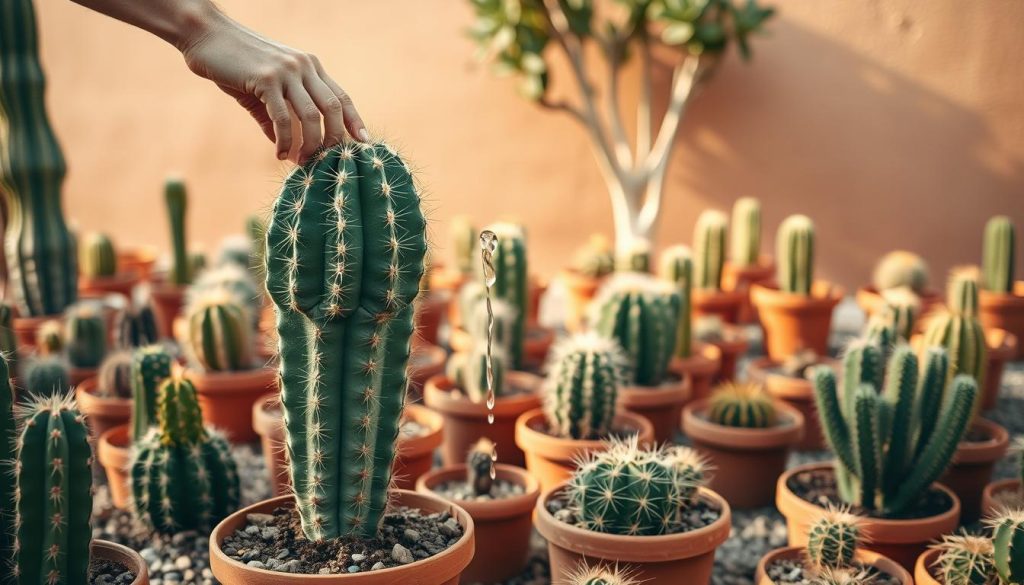
When to water your cactus is very important. It depends on a few things:
- Morning watering lets soil dry during the day
- Don’t water in the evening to avoid moisture
- Water on warm, sunny days
Choosing the Right Water
The type of water you use matters a lot. Different waters can affect your cactus’s health:
- Filtered water helps avoid mineral buildup
- Rainwater is natural and soft
- Tap water might have chemicals bad for cacti
Water Temperature Considerations
The water’s temperature is important for your cactus. Room temperature water is best. Water that’s too cold or hot can hurt the roots.
Experts say to let tap water sit for 24 hours before using it. This lets chlorine evaporate and makes the water the right temperature for your succulent.
Understanding Soil Drainage Requirements
Cactus care in arid climates relies heavily on soil drainage. The right soil mix can be the difference between a thriving cactus and one that struggles. Proper drainage stops water from pooling around roots, preventing root rot and decay.
Choosing the perfect soil for cacti means understanding their unique needs. These plants thrive in dry conditions, making soil composition key.
Importance of Well-Draining Soil
Well-draining soil offers many benefits for cactus health:
- Prevents water from gathering around roots
- Mimics desert growing conditions
- Reduces fungal infections
- Supports healthy root growth
Best Soil Mixes for Cacti
To create the best cactus soil mix, combine these ingredients for great drainage:
- Coarse sand (50%)
- Potting soil (25%)
- Perlite or pumice (25%)
Tips for Improving Drainage
Improving soil drainage is easy with a few techniques. Use terracotta pots with holes, add rocks to the bottom, and avoid water-retentive materials. These steps can greatly improve your cactus care.
Fertilizing vs. Watering: Finding the Balance
Cactus care is all about finding the right balance between fertilizing and watering. Desert plants need special care, including the right nutrients. Fertilizing your cactus correctly can help it grow strong and healthy.
Optimal Fertilization Timing
Cacti grow best at certain times. Here are the best times to feed your desert plants:
- Early spring when growth begins
- Throughout the active growing season (spring and summer)
- Avoiding fertilization during dormant winter months
Impact of Fertilization on Water Requirements
Fertilizing your cactus can change how often it needs water. When it’s growing, it might need more water. Use a cactus fertilizer that is:
- Low in nitrogen
- High in phosphorus and potassium
- Diluted to half the recommended strength
Watching how your cactus reacts to fertilizing is key. Look for changes in its appearance. Adjust your watering based on its needs. This balance helps your cactus grow well without getting too wet or too dry.
Every cactus is different. Learn what your cactus needs to keep it healthy and vibrant.
Troubleshooting Common Watering Issues
Learning how to water cacti can be tricky. Knowing the right way to water them helps avoid problems. These issues can harm these tough desert plants.
Identifying Underwatered Cacti
Underwatered cacti show clear signs that need quick action. Spotting these signs is key to caring for your cactus:
- Wrinkled or shriveled appearance
- Dry and brittle stem texture
- Stunted growth patterns
- Pale or faded color
Spotting Overwatered Cactus Symptoms
Too much water can harm cacti too. Look out for these signs of overwatering:
- Soft, mushy base or stems
- Yellowing or translucent skin
- Dark, soggy roots
- Fungal growth around the plant base
Adjusting Your Watering Technique
Good cactus care means watching and acting fast. First, check the soil moisture with your finger or a moisture meter. Then, change how often you water based on the season and your plant’s needs.
Every cactus type needs different water amounts. Creating a watering plan that fits your plant’s needs will help it grow well.
Tools and Equipment for Effective Watering
Mastering proper cactus irrigation needs the right tools and equipment. Choosing the right watering instruments can make your low-water gardening better. It ensures your cacti get the best care with precision and ease.
Having the right equipment is key to successful cactus care. The right tools help keep your desert plants at the perfect moisture level. Here are some tools you’ll need:
Recommended Watering Tools
- Long-spouted watering cans for targeted irrigation
- Squeeze bottles with narrow tips for precise water delivery
- Spray bottles for light misting of smaller cacti
- Specialized desert plant watering containers
Soil Moisture Meters
Digital soil moisture meters are a big help for watering cacti. They let you:
- Measure exact moisture levels in cactus soil
- Prevent overwatering and root rot
- Provide accurate readings for different cactus species
- Help track watering needs across seasons
Watering Schedules and Reminders
Technology supports low-water gardening with smart apps and reminders. Many gardening apps offer customized watering schedules and tracking features. They send notifications to ensure your cacti get consistent care.
Investing in quality tools makes cactus care precise and enjoyable. By using these specialized instruments, you’ll create the best environment for your desert plants to thrive.
Conclusion: Mastering Cactus Care
Successful indoor cactus care needs attention and understanding. It requires patience, observation, and a willingness to learn. By following the techniques in this guide, you can improve your desert plant care.
Each cactus is unique, needing its own care plan. The key to cactus care is knowing how to water, understand their environment, and meet their specific needs. Learning these skills will help you create a thriving space for your desert plants.
Learning cactus care is a journey. Start by watching how your plant reacts to different watering, soil, and light. With time, you’ll understand your cactus’s health and growth. This will ensure it thrives and looks beautiful for years.
Every cactus lover started as a beginner. Your commitment to learning about these plants will pay off. You’ll have stunning, resilient plants that make your home feel like a desert oasis.
